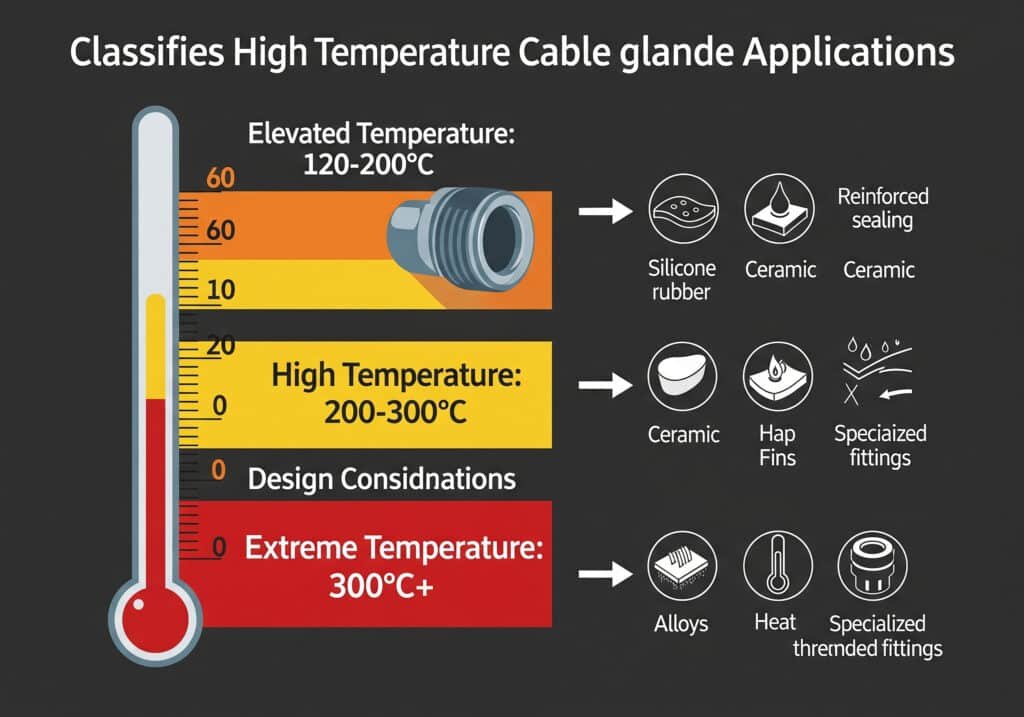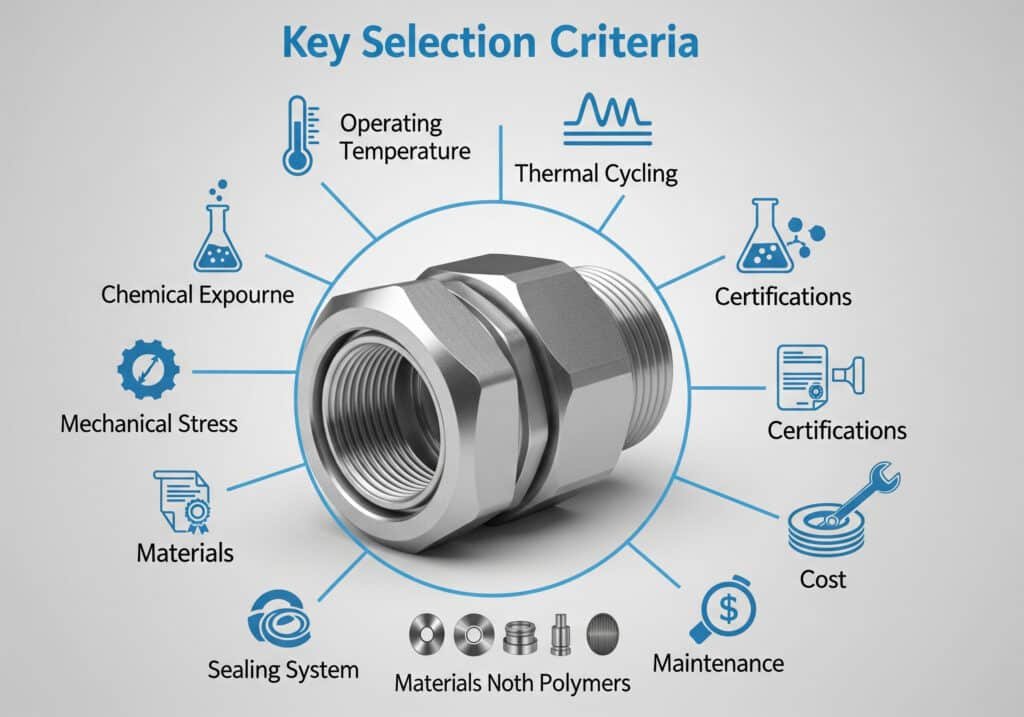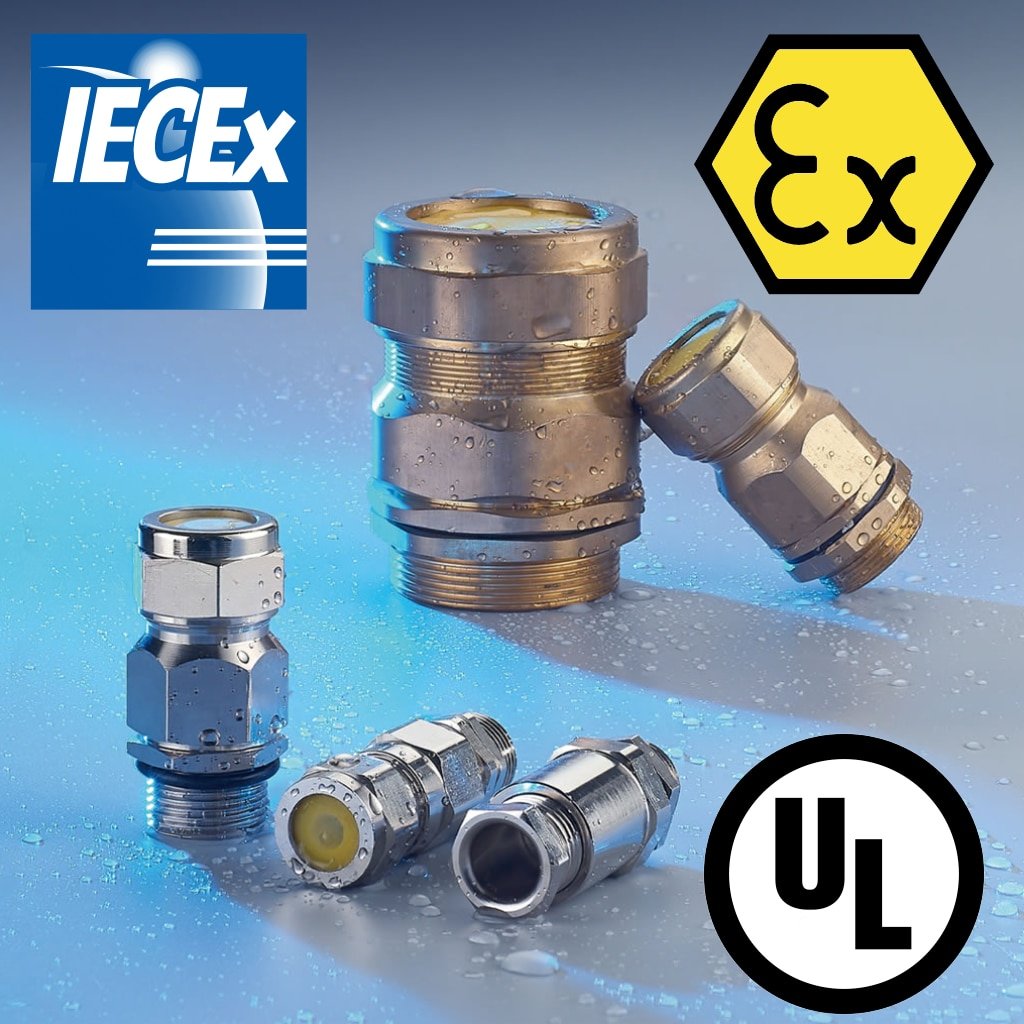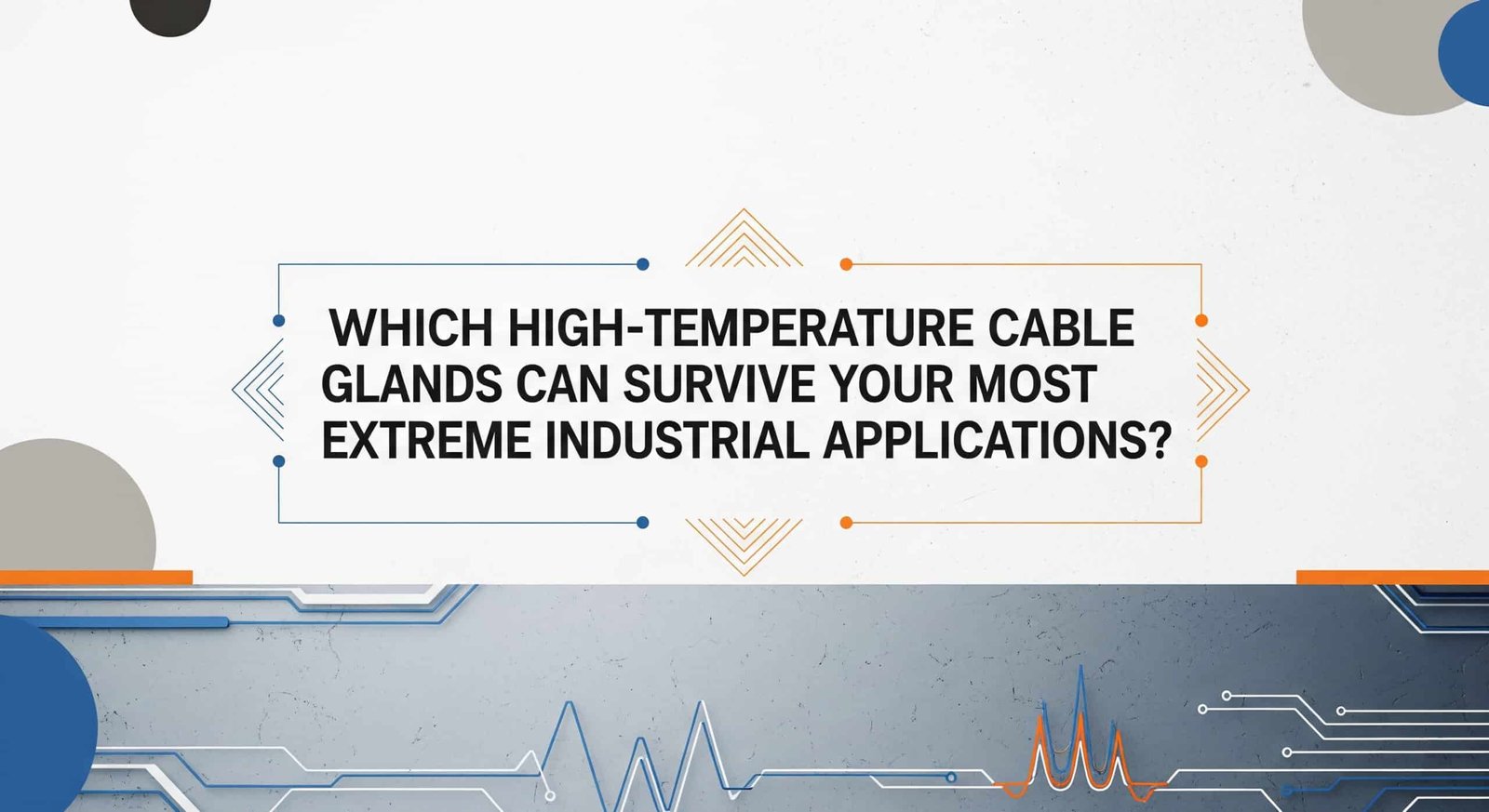Introduction
Standard cable glands fail catastrophically at 150°C, turning into melted plastic disasters that can shut down entire production lines and cost millions in downtime. Yet industrial applications routinely demand cable connections that withstand temperatures exceeding 300°C – from steel mills and glass furnaces to petrochemical refineries and power generation facilities. The wrong gland selection doesn’t just mean equipment failure; it means safety hazards, production shutdowns, and emergency repairs in dangerous environments.
High-temperature cable glands for extreme industrial applications require specialized materials like PEEK, PTFE, or high-grade stainless steel, temperature ratings from 200°C to 500°C+, proper thermal expansion management, and flame-resistant certifications to ensure reliable performance in furnaces, refineries, aerospace, and other demanding environments where standard glands would fail within hours.
Last month, Hassan, operations manager at a petrochemical refinery in Saudi Arabia, watched helplessly as 47 standard nylon cable glands melted during a process upset that raised ambient temperatures to 280°C. The resulting cable failures triggered an emergency shutdown, costing $2.3 million in lost production and requiring a hazardous hot-work repair operation. This comprehensive guide ensures you select the right high-temperature glands before disaster strikes.
Table of Contents
- What Temperature Ranges Define High-Temperature Cable Gland Applications?
- Which Materials Can Withstand Extreme Industrial Heat?
- How Do You Select Glands for Specific High-Temperature Applications?
- What Are the Critical Installation and Maintenance Considerations?
- Which Certifications and Standards Apply to High-Temperature Glands?
- FAQs About High-Temperature Cable Glands
What Temperature Ranges Define High-Temperature Cable Gland Applications?
Understanding temperature classifications isn’t just academic – it’s the difference between reliable operation and catastrophic failure in extreme industrial environments.
High-temperature cable gland applications are classified into elevated temperature (120-200°C), high temperature (200-300°C), and extreme temperature (300°C+) ranges, each requiring specific material selections, design considerations, and certification standards based on continuous operating conditions rather than brief temperature spikes.

Temperature Classification System
Elevated Temperature Applications (120-200°C):
- Typical environments: Motor control centers, transformer rooms, industrial ovens
- Duration: Continuous operation for years
- Material options: High-temperature nylon, brass with EPDM seals
- Common failures: Standard nylon becomes brittle, PVC cables degrade
- Industry examples: Food processing, automotive manufacturing, HVAC systems
High Temperature Applications (200-300°C):
- Typical environments: Steel mills, glass furnaces, chemical reactors
- Duration: Continuous exposure with thermal cycling
- Material requirements: Stainless steel, PEEK, PTFE sealing
- Critical factors: Thermal expansion, oxidation resistance
- Industry examples: Primary metals, glass manufacturing, chemical processing
Extreme Temperature Applications (300°C+):
- Typical environments: Furnace monitoring, aerospace engines, nuclear facilities
- Duration: Intermittent to continuous depending on application
- Material requirements: Specialized alloys, ceramic components
- Design challenges: Thermal shock, material compatibility
- Industry examples: Aerospace, nuclear power, specialty metallurgy
Real-World Temperature Challenges
Hassan’s Saudi refinery operates multiple temperature zones that challenge standard cable gland selections:
Refinery Temperature Mapping:
- Control room environment: 25-45°C (standard glands acceptable)
- Process unit areas: 80-150°C (elevated temperature glands required)
- Furnace proximity zones: 200-350°C (high-temperature specialized glands)
- Emergency flare systems: 400-600°C (extreme temperature ceramic-lined glands)
- Catalyst regeneration units: 500-700°C (custom engineered solutions)
Temperature Cycling Impact:
Industrial environments rarely maintain constant temperatures. Daily and seasonal cycling creates additional stresses:
| Application | Daily Range | Seasonal Range | Cycling Frequency |
|---|---|---|---|
| Steel Mill Furnace | 300-500°C | 250-550°C | 3-5 cycles/day |
| Glass Annealing | 400-600°C | 350-650°C | 2-3 cycles/day |
| Chemical Reactor | 180-280°C | 150-300°C | 1-2 cycles/day |
| Power Plant Turbine | 200-400°C | 180-420°C | 1 cycle/day |
Measurement and Monitoring Considerations
Accurate Temperature Assessment:
Many installations fail because engineers underestimate actual operating temperatures:
- Ambient vs. surface temperature: Cable glands may experience 50-100°C higher than ambient
- Radiant heat1 effects: Proximity to hot surfaces increases gland temperature significantly
- Thermal bridging: Metal conduits can conduct heat from hot zones to gland locations
- Insulation effectiveness: Poor insulation allows heat migration to “cooler” areas
At Bepto, we provide temperature monitoring services for critical installations, using thermal imaging and data logging to verify actual operating conditions before recommending gland specifications. This approach prevented Hassan’s refinery from repeating their costly mistake.
Which Materials Can Withstand Extreme Industrial Heat?
Material selection determines whether your cable glands protect your installation or become the weakest link in extreme temperature environments.
High-temperature cable gland materials include engineering plastics (PEEK, PPS, PTFE) for 200-300°C applications, stainless steel alloys (316L, Inconel, Hastelloy) for 300-500°C service, and specialized ceramics or refractory metals for extreme applications exceeding 500°C, each with specific advantages and limitations.
Engineering Plastic Solutions
- Temperature range: Continuous service to 250°C, intermittent to 300°C
- Advantages: Excellent chemical resistance, dimensional stability, lightweight
- Limitations: Higher cost than standard materials, limited color options
- Applications: Chemical processing, aerospace, medical device manufacturing
PPS (Polyphenylene Sulfide):
- Temperature range: Continuous service to 220°C, short-term to 260°C
- Advantages: Good chemical resistance, flame retardant, cost-effective
- Limitations: Brittle at low temperatures, limited impact resistance
- Applications: Automotive electronics, industrial controls, pump housings
PTFE (Polytetrafluoroethylene):
- Temperature range: Continuous service to 260°C, intermittent to 300°C
- Advantages: Outstanding chemical inertness, non-stick properties
- Limitations: Soft material, requires careful installation, expensive
- Applications: Chemical processing, food industry, pharmaceutical manufacturing
Metallic Material Options
316L Stainless Steel:
- Temperature range: Continuous service to 400°C in non-oxidizing environments
- Advantages: Excellent corrosion resistance, good strength, readily available
- Limitations: Work hardening, potential chloride stress corrosion
- Applications: Food processing, marine environments, general chemical service
- Temperature range: Continuous service to 650°C, intermittent to 800°C
- Advantages: Superior high-temperature strength, oxidation resistance
- Limitations: Expensive, difficult to machine, limited availability
- Applications: Aerospace engines, nuclear reactors, advanced chemical processing
Hastelloy C-276:
- Temperature range: Continuous service to 675°C in specific environments
- Advantages: Outstanding corrosion resistance, thermal stability
- Limitations: Very expensive, specialized welding requirements
- Applications: Chemical processing, pollution control, nuclear waste processing
Material Performance Comparison
Marcus, chief engineer at a steel mill in Germany, learned the importance of proper material selection after experiencing multiple gland failures:
Steel Mill Application Analysis:
- Initial selection: Standard brass glands with EPDM seals
- Operating conditions: 280°C continuous, 350°C peaks, scale-laden atmosphere
- Failure mode: Brass oxidation, seal degradation, cable jacket damage
- Solution: 316L stainless steel with PTFE seals and heat shields
Performance Results After Upgrade:
| Parameter | Brass/EPDM | 316L/PTFE | Improvement |
|---|---|---|---|
| Service life | 3-6 months | 24+ months | 400-800% |
| Failure rate | 15% annually | <2% annually | 87% reduction |
| Maintenance cost | €12,000/year | €2,800/year | 77% savings |
| Downtime hours | 48 hours/year | 6 hours/year | 87% reduction |
Sealing System Considerations
High-Temperature Seal Materials:
Viton (FKM) Fluoroelastomer:
- Temperature range: -20°C to +200°C continuous
- Chemical compatibility: Excellent with most industrial chemicals
- Applications: General industrial, automotive, aerospace
EPDM (Ethylene Propylene Diene Monomer):
- Temperature range: -40°C to +150°C continuous
- Advantages: Good ozone resistance, steam service capability
- Limitations: Poor petroleum product resistance
Silicone Rubber:
- Temperature range: -60°C to +200°C continuous, brief exposure to 250°C
- Advantages: Excellent flexibility retention, FDA approved grades available
- Limitations: Poor tear resistance, limited chemical compatibility
PTFE Gaskets:
- Temperature range: -200°C to +260°C continuous
- Advantages: Universal chemical compatibility, non-contaminating
- Limitations: Cold flow4 under load, requires proper bolt torque
At Bepto, we maintain extensive material compatibility databases and can provide custom material combinations for specific applications. Our engineering team works directly with customers like Marcus to optimize material selection based on actual operating conditions rather than theoretical specifications. 😉
How Do You Select Glands for Specific High-Temperature Applications?
Selecting high-temperature cable glands requires matching material properties, thermal characteristics, and environmental conditions to ensure long-term reliability in extreme industrial environments.
High-temperature cable gland selection involves analyzing continuous operating temperature, thermal cycling patterns, chemical exposure, mechanical stresses, and certification requirements to match appropriate materials, sealing systems, and design features for specific industrial applications while considering cost-effectiveness and maintenance requirements.

Application-Specific Selection Criteria
Steel and Metals Industry:
Hassan’s experience with petrochemical applications translates well to steel industry requirements:
- Primary concerns: Scale formation, thermal shock, mechanical vibration
- Temperature profiles: 200-400°C continuous with 500°C+ spikes
- Environmental factors: Steam, scale particles, reducing atmospheres
- Recommended materials: 316L stainless steel with ceramic fiber insulation
- Special features: Extended threads for thick refractory walls
Glass Manufacturing:
- Primary concerns: Alkali vapor exposure, thermal cycling, radiant heat
- Temperature profiles: 300-600°C continuous operation
- Environmental factors: Sodium/potassium vapors, thermal shock
- Recommended materials: Inconel 625 with PTFE seals
- Special features: Heat shields and thermal barriers
Chemical Processing:
- Primary concerns: Chemical compatibility, pressure cycling, safety
- Temperature profiles: 150-350°C depending on process
- Environmental factors: Corrosive chemicals, pressure variations
- Recommended materials: Hastelloy or 316L with Viton seals
- Special features: Explosion-proof certifications, drain provisions
Thermal Management Strategies
Heat Shield Design:
Effective heat shielding can reduce gland operating temperature by 100-200°C:
Shield Types and Effectiveness:
| Shield Type | Temperature Reduction | Installation Complexity | Cost Factor |
|---|---|---|---|
| Reflective foil | 50-80°C | Simple | 1.2x |
| Ceramic fiber | 100-150°C | Moderate | 1.8x |
| Refractory brick | 150-250°C | Complex | 3.5x |
| Active cooling | 200-400°C | Very complex | 8-12x |
Thermal Expansion Management:
Marcus’s steel mill installation required careful attention to thermal expansion:
- Gland body expansion: 316L expands ~18mm/meter at 300°C
- Panel expansion: Steel panels expand at different rates than glands
- Cable expansion: XLPE cables expand significantly with temperature
- Solution: Flexible conduit connections and expansion joints
Environmental Compatibility Assessment
Chemical Exposure Analysis:
Different industries present unique chemical challenges:
Petrochemical Environments (Hassan’s Application):
- Hydrocarbons: Require fluoroelastomer seals, avoid standard rubber
- H2S exposure: Demands sulfide-resistant alloys like 316L or Inconel
- Caustic cleaning: Periodic NaOH exposure requires alkaline-resistant materials
- Steam service: High-temperature steam demands specific seal materials
Power Generation Applications:
- Coal-fired plants: Fly ash abrasion, SO2 exposure, thermal cycling
- Natural gas plants: High temperatures, pressure cycling, moisture
- Nuclear facilities: Radiation exposure, strict material traceability
- Renewable energy: UV exposure, temperature cycling, vibration
Cost-Benefit Analysis Framework
Total Cost of Ownership Calculation:
High-temperature glands cost 3-10x more than standard glands, but the total cost analysis often favors premium materials:
Cost Components:
- Initial gland cost: $50-500 per gland depending on material/size
- Installation labor: $100-300 per gland for specialized installation
- Maintenance frequency: Standard glands may require annual replacement
- Downtime costs: $10,000-100,000 per hour for major industrial processes
- Safety incidents: Potential millions in liability and regulatory costs
Marcus’s Steel Mill ROI Analysis:
- Premium gland cost: €180 vs €25 for standard (7.2x multiplier)
- Service life improvement: 24 months vs 4 months (6x improvement)
- Maintenance labor savings: €8,000 annually
- Downtime reduction: 42 hours annually @ €15,000/hour = €630,000
- Total annual savings: €638,000 for €4,500 additional gland investment
- ROI: 14,200% return on investment
At Bepto, we provide comprehensive application analysis and total cost modeling to help customers make informed decisions. Our technical team can visit your facility to assess actual operating conditions and recommend optimized solutions that balance performance with cost-effectiveness.
What Are the Critical Installation and Maintenance Considerations?
Proper installation and maintenance of high-temperature cable glands requires specialized techniques, tools, and procedures that differ significantly from standard gland practices.
High-temperature cable gland installation demands pre-heating considerations, thermal expansion allowances, specialized torque specifications, heat-resistant cable selection, proper insulation techniques, and scheduled maintenance protocols to prevent premature failure and ensure long-term reliability in extreme environments.
Pre-Installation Preparation
Temperature Mapping and Assessment:
Before installing high-temperature glands, conduct thorough temperature surveys:
- Thermal imaging surveys: Identify actual vs. assumed temperatures
- Data logging: Monitor temperature variations over complete operating cycles
- Heat source analysis: Identify primary and secondary heat sources
- Airflow patterns: Understand how ventilation affects local temperatures
Cable Selection Compatibility:
High-temperature glands are only as good as the cables they terminate:
Cable Temperature Ratings:
| Cable Type | Continuous Rating | Peak Rating | Typical Applications |
|---|---|---|---|
| XLPE | 90°C | 130°C | Standard industrial |
| EPR | 105°C | 140°C | Motor connections |
| Silicone rubber | 180°C | 200°C | High-temp industrial |
| PTFE | 260°C | 300°C | Extreme applications |
| Mineral insulated | 250°C+ | 1000°C+ | Fire survival circuits |
Installation Procedures
Thermal Expansion Calculations:
Marcus’s steel mill team learned to calculate and accommodate thermal expansion:
Expansion Formula: ΔL = α × L₀ × ΔT
- α: Coefficient of thermal expansion (material-specific)
- L₀: Original length at reference temperature
- ΔT: Temperature change from reference
Practical Example:
- 316L stainless steel gland: α = 18 × 10⁻⁶ /°C
- Gland length: 60mm
- Temperature rise: 250°C (20°C to 270°C)
- Expansion: 18 × 10⁻⁶ × 60 × 250 = 0.27mm
Installation Torque Specifications:
High-temperature applications require modified torque values:
| Gland Size | Standard Torque | High-Temp Torque | Reason |
|---|---|---|---|
| M20 | 15-20 Nm | 12-15 Nm | Thermal expansion |
| M25 | 25-30 Nm | 20-25 Nm | Material softening |
| M32 | 35-40 Nm | 28-35 Nm | Seal compression |
| M40 | 45-50 Nm | 38-45 Nm | Stress relief |
Maintenance Protocols
Scheduled Inspection Requirements:
High-temperature glands require more frequent inspection than standard applications:
Inspection Schedule:
- Initial: 30 days after installation
- Regular: Every 90 days for first year
- Ongoing: Every 180 days after first year
- Emergency: After any temperature excursion >110% of design
Inspection Checklist:
- Visual inspection for cracks, discoloration, or deformation
- Torque verification on accessible connections
- Insulation resistance testing of terminated cables
- Thermal imaging to identify hot spots
- Documentation of any changes or anomalies
Predictive Maintenance Indicators:
Hassan’s refinery now monitors several key indicators:
- Surface temperature trends: Gradual increases indicate seal degradation
- Insulation resistance decline: Early warning of moisture ingress
- Vibration changes: May indicate loose connections or mounting issues
- Visual appearance changes: Discoloration, cracking, or surface oxidation
Troubleshooting Common Issues
Premature Seal Failure:
- Symptoms: Moisture ingress, reduced insulation resistance
- Causes: Incorrect material selection, over-torquing, thermal cycling
- Solutions: Upgrade seal material, adjust torque, add thermal barriers
Gland Body Cracking:
- Symptoms: Visible cracks, especially around threads
- Causes: Thermal shock, material incompatibility, over-constraint
- Solutions: Material upgrade, stress relief, thermal gradients
Cable Jacket Degradation:
- Symptoms: Brittle or soft cable jacket at gland interface
- Causes: Temperature rating exceeded, chemical incompatibility
- Solutions: Cable upgrade, heat shielding, chemical barrier
Thread Galling:
- Symptoms: Difficulty removing or installing glands
- Causes: Dissimilar metals, high temperatures, inadequate lubrication
- Solutions: Anti-seize compounds, material compatibility, proper torque
At Bepto, we provide comprehensive installation training and maintenance support for high-temperature applications. Our field service team can assist with initial installations and provide ongoing technical support to ensure optimal performance throughout the gland service life.
Which Certifications and Standards Apply to High-Temperature Glands?
Understanding certification requirements for high-temperature cable glands ensures compliance with safety regulations and performance standards across different industries and geographic regions.
High-temperature cable gland certifications include UL recognition for North American markets, ATEX/IECEx for explosive atmospheres, marine certifications for offshore applications, nuclear qualifications for power plants, and industry-specific standards like NEMA, IP ratings, and fire survival requirements that validate performance under extreme conditions.

Primary Certification Bodies and Standards
UL (Underwriters Laboratories) – North America:
- UL 514B5: Conduit, tubing, and cable fittings
- Temperature ratings: Specific temperature classifications (T1-T6)
- Testing requirements: Thermal cycling, aging tests, flammability
- Market access: Required for most North American industrial applications
ATEX (European Union) and IECEx (International):
- Explosive atmosphere protection: Essential for petrochemical applications like Hassan’s refinery
- Temperature classifications: T1 (450°C) through T6 (85°C surface temperature)
- Construction requirements: Flameproof, increased safety, intrinsic safety
- Documentation: Detailed technical files and quality assurance procedures
Marine Certifications:
- DNV GL: Det Norske Veritas – Germanischer Lloyd
- ABS: American Bureau of Shipping
- Lloyd’s Register: International marine classification
- Requirements: Salt spray resistance, vibration, temperature cycling
Industry-Specific Requirements
Nuclear Power Applications:
Marcus’s experience with conventional power plants differs significantly from nuclear requirements:
Nuclear Qualification Standards:
- IEEE 323: Qualifying electrical equipment for nuclear facilities
- IEEE 383: Fire-resistant cables and cable systems
- 10 CFR 50.49: Environmental qualification requirements
- Testing requirements: Radiation exposure, LOCA (Loss of Coolant Accident) simulation
Aerospace Applications:
- AS9100: Quality management for aerospace
- RTCA DO-160: Environmental conditions and test procedures
- FAA/EASA approvals: Required for commercial aviation
- Material traceability: Complete supply chain documentation
Petrochemical Industry Standards:
Hassan’s refinery must comply with multiple overlapping standards:
- API RP 500: Classification of locations for electrical installations
- NFPA 70: National Electrical Code (US)
- IEC 60079: Explosive atmospheres standards series
- Local regulations: Saudi SASO, European ATEX, etc.
Performance Testing Requirements
Thermal Testing Protocols:
High-temperature glands undergo rigorous testing to verify performance claims:
Standard Test Sequences:
- Initial inspection: Dimensional verification, material analysis
- Thermal aging: Extended exposure at rated temperature
- Thermal cycling: Repeated heating/cooling cycles
- Mechanical testing: Tensile strength, impact resistance
- Environmental exposure: Chemical resistance, UV exposure
- Final verification: Dimensional stability, seal integrity
Typical Test Parameters:
| Test Type | Duration | Temperature | Cycles | Pass Criteria |
|---|---|---|---|---|
| Thermal aging | 1000 hours | Rated temp | Continuous | <10% property change |
| Thermal cycling | 500 cycles | -40°C to rated | 500 | No cracking/leakage |
| Chemical exposure | 168 hours | 23°C | N/A | <5% weight change |
| UV exposure | 1000 hours | 60°C | N/A | No surface degradation |
Certification Process and Timeline
Typical Certification Timeline:
- Pre-submission: 2-4 weeks for documentation preparation
- Initial review: 4-6 weeks for technical file assessment
- Testing phase: 12-16 weeks for complete test program
- Report generation: 4-6 weeks for final certification documents
- Total timeline: 6-8 months for complete certification
Cost Considerations:
Certification costs vary significantly by scope and complexity:
- Basic UL listing: $15,000-30,000 per product family
- ATEX certification: $25,000-50,000 per product family
- Nuclear qualification: $100,000-500,000 per product family
- Multiple certifications: Economies of scale reduce per-certification costs
Maintaining Certification Compliance
Ongoing Requirements:
Certification isn’t a one-time event – it requires ongoing compliance:
Quality System Maintenance:
- Annual audits: Certification body facility inspections
- Change control: Any design changes require re-evaluation
- Production monitoring: Ongoing surveillance of manufacturing
- Documentation updates: Maintaining current technical files
Field Installation Compliance:
- Installer training: Proper installation techniques for certified performance
- Installation documentation: Maintaining traceability for critical applications
- Periodic inspection: Verifying continued compliance in service
- Incident reporting: Documenting any failures or issues
At Bepto, we maintain multiple certifications across our high-temperature product lines and can guide customers through the certification requirements for their specific applications. Our quality team ensures ongoing compliance and can provide the documentation needed for regulatory approval in critical industries. 😉
Conclusion
Selecting the right high-temperature cable glands isn’t just about withstanding heat – it’s about ensuring reliable operation, safety compliance, and cost-effective performance in the world’s most demanding industrial environments. From Hassan’s petrochemical refinery to Marcus’s steel mill, the lessons are clear: invest in proper materials, understand your actual operating conditions, and plan for thermal management from the beginning. The premium cost of high-temperature glands pays for itself many times over through reduced downtime, improved safety, and extended service life. Remember, in extreme temperature applications, there’s no such thing as “good enough” – only solutions that work reliably for years or expensive failures that shut down operations.
FAQs About High-Temperature Cable Glands
Q: What’s the difference between continuous and intermittent temperature ratings for cable glands?
A: Continuous ratings indicate 24/7 operation capability while intermittent ratings allow brief temperature excursions. A gland rated for 250°C continuous might handle 300°C for short periods, but prolonged exposure at the higher temperature will cause premature failure.
Q: Can I use standard cables with high-temperature cable glands?
A: No, the cable temperature rating must match or exceed the gland’s operating environment. Standard PVC cables rated for 70°C will fail quickly at 200°C regardless of gland material. Always match cable and gland temperature capabilities.
Q: How do I calculate thermal expansion for high-temperature gland installations?
A: Use the formula ΔL = α × L₀ × ΔT, where α is the material’s thermal expansion coefficient, L₀ is original length, and ΔT is temperature change. For 316L stainless steel, α = 18 × 10⁻⁶ per °C.
Q: Which certifications are required for high-temperature glands in explosive atmospheres?
A: ATEX (Europe) or IECEx (International) certifications are mandatory for explosive atmosphere applications. These include temperature classification (T1-T6) and protection method (flameproof, increased safety, etc.) based on your specific hazardous area requirements.
Q: How often should high-temperature cable glands be inspected and maintained?
A: Inspect every 30 days initially, then every 90 days for the first year, and every 180 days thereafter. Include visual inspection, torque verification, insulation resistance testing, and thermal imaging to identify potential issues before failure occurs.
-
Learn the physics of heat transfer, including conduction, convection, and the principles of radiant heat. ↩
-
Review a technical data sheet on the properties of PEEK (Polyetheretherketone), including its thermal and chemical resistance. ↩
-
Explore the material properties of Inconel 625, a nickel-based superalloy used in extreme temperature and corrosive environments. ↩
-
Understand the material science concept of cold flow (creep) and how it affects the long-term performance of plastic seals. ↩
-
See the scope and requirements of the UL 514B safety standard for conduit, tubing, and cable fittings. ↩



